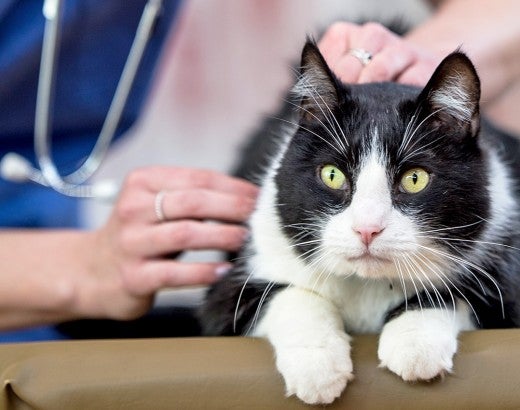You can help pets in your own neighborhood by getting to know your neighbors and familiarizing yourself with local food pantries, shelters and other pet services in your community. Donating small amounts of your time, resources or expertise to companion animal causes at a local level can strengthen the support network for pets (and their owners) in your community and reduce shelter surrenders and strays.
Visit PetHelpFinder for financially-friend veterinary and other pet care services.
Contents
- Get to know your neighbors and their pets
- Donate pet food
- Donate toward pet care
- Help a lost dog or cat
- Volunteer for animals
- Become a temporary foster
- Make your voice heard
Get to know your neighbors and their pets
Getting to know your neighbors can have a huge impact on fostering a sense of community. Introduce yourself to their pets too! When you build meaningful relationships, you open up opportunities to help each other. You can offer to drive your neighbor to veterinary appointments, keep them informed of low-cost vaccine or spay/neuter clinics in the area and pass on supplies that they might need, like leashes or pet food. Some neighbors might even need help with something as simple as brushing or bathing their dog.
Donate pet food
Reach out to your local animal shelter or community food bank to find out if they have a pet food pantry in need of supplies. You can also organize a local pet food drive in your neighborhood to help families in need of pet supplies. You might even have houseless neighbors in your community with furry friends who need support. Find out how you can help feed pets of the homeless.
Donate toward pet care
It’s heartbreaking when a pet is sick or in pain. Unexpected or emergency veterinary care can be expensive and for many families it can add an undue burden on their finances. When you help local families cover their pets’ health expenses, you’re helping the pets in your community live long, happy lives in loving homes.
-
Reach out to a local veterinary clinic or hospital. If you have a pet, start by contacting your pet’s veterinary clinic or hospital to see if they have a fund to which you can contribute to help with the medical expenses of a local pet in need.
-
Check with local pet organizations. Search online for local pet shelters and rescues. Visit their website to see if they have a fund for veterinary care to which you can donate.
-
Support vet care assistance programs in your state. Use the Banfield Foundation’s resources for pet owners to find a list of organizations that offer vet care assistance in your state. Visit an organization’s website to check if they accept donations for veterinary expenses of pets in your community.
-
Set up a fundraiser for a pet in need. If a friend, family member or neighbor needs help covering their pet’s veterinary bills, offer to help organize a personal fundraiser. Crowdfunding websites like Waggle and GoFundMe make it easy to set up a webpage to collect donations on their behalf. Banfield Foundation’s resources for pet owners lists additional crowdfunding sites.
-
Donate toward the veterinary care of one of Waggle's pets in crisis.
-
Inform local veterinarians about the AVMF REACH Program ™, which provides grants to veterinarians who are current members of the American Veterinary Medical Association and who have already provided discounted emergency veterinary medical care for an animal whose owners are experiencing financial hardship.
Help a lost dog or cat
Pets and people belong together. When a pet gets lost, it’s scary and stressful for them—and for their family and friends. If your cat or dog is missing, or you want to help find someone else's lost pet, stay calm and take action. Start searching as soon as possible.
Everyone in the community has a role to play in reuniting lost pets with their families. From hanging flyers to checking local shelters, you can help missing pets get home safely.
What to do if you find a dog or cat
-
Determine if the cat or dog needs your help. If the pet looks healthy, help them find their family. If the pet looks sick, injured, underfed, dirty or in pain, they probably need help. If they appear to be in danger or in need of immediate assistance, call your local animal services agency.
-
Check the pet's collar for tags. If it’s safe to do so, approach the cat or dog to check their collar for tags. If there is a phone number for their family, let them know you found their pet. A majority of found pets lives nearby.
-
No tags? Ask around. A neighbor, mail carrier, delivery person or gardener may recognize the pet and know where they live. Knock on neighborhood doors to ask the neighbors if they know the pet and where the pet lives. Take a walk through the neighborhood and look for "lost cat" or “lost dog” signs.
-
Find out if the pet has a microchip. Contact a local veterinarian, fire department, pet store or animal shelter to see if they can scan the cat or dog for a microchip and contact information for their family.
-
File a found pet report with your local animal shelter. If the cat or dog has been reported missing, the shelter can help them get home safely. If you are able to care for the pet temporarily, do so and provide the animal shelter your contact information. Do not take the pet to the animal shelter as it will make it harder for the family to find them. This is especially important for cats, as only 2% of cats brought to shelters are reunited with their families. If you can't care for the pet yourself, consider finding them a short-term foster home and notify the animal shelter in case they are contacted.
-
Take clear photos of the cat or dog. Print flyers to hang in the area and share the photos online. Include when and where the pet was found, along with your contact information. Post the photos to Petco's Love Lost database, PawBoost, Pet FBI, Nextdoor, Craigslist, local lost-and-found pet groups on Facebook and your personal social media pages. While you're online, check for "lost pet" posts that could be about the same cat or dog.
Volunteer for animals
Volunteering is a great way to offer help to your community! Check with your local animal shelter for volunteer opportunities. You can also volunteer at a local spay/neuter or vaccine clinic, which tend to be busy events where help is needed. Our Pets for Life and Rural Area Veterinary Services programs also offer volunteer opportunities throughout the year, and we’re always seeking volunteers for our Humane Ally program, who work on a state level. Volunteers are essential partners in our lifesaving work for all animals and are an integral part of this community of compassionate individuals, all of whom are deeply committed to advancing humane public policies for all animals.
Become a temporary foster
Can you provide a temporary home for a cat or dog? Fostering is a short-term commitment to care for a pet. Sometimes, people in your community may need temporary help with pet care because of a military deployment, medical issue or other urgent situation. By fostering someone’s pet for them, you provide peace of mind, valuable support and help to keep their family together. Many shelter and foster-based organizations post fostering opportunities on their websites. Check under “Foster” or “Volunteer.” If you can’t find the information online, call or email and tell them you’re interested in fostering. Otherwise, you can help friends, family members and neighbors by stepping in during emergencies:
-
If a friend, family member or neighbor is unable to care for their pet, offer to help. Let them know you are interested in giving their pet a safe and loving temporary home.
-
Sign an agreement. When you agree to foster someone’s pet, put the fostering arrangement in writing. A foster care agreement spells out the arrangement between the pet's owner and the pet's caretaker, including who will cover the cost of food and vet visits. Download a sample temporary pet guardian contract from the Animal Welfare Association.
-
Prepare your home. Ask the cat or dog’s family for tips on creating a safe and welcoming environment for your foster pet. To "pet-proof" your home, move anything that could be dangerous to the pet out of reach, including people food and house plants, medications, cleaning products and electrical wires. If you have other pets, learn about how to safely introduce a new cat or a new dog to your family.
-
Stock up on supplies. Ask about the pet’s favorite foods, toys and bedding. You will likely need pet food and treats, food and water bowls, a cozy bed, grooming supplies, and toys, among other things. The pet’s family may provide these, or you may be able to find supplies for free on Nextdoor, Craigslist or through a Buy Nothing group.
-
Care for your foster pet with love and patience. Depending on the pet’s personality, they may feel confused or anxious to be in a different place, at least at first. Learn how to help a shy cat or nervous dog feel comfortable in your home.
-
Take photos and videos of your foster pet. If you are fostering for the pet’s family, send them photos and updates of how their cat or dog is doing. You can take great pet photos with your smartphone.
Make your voice heard
Your voice and your vote can make a big impact for all animals. Your elected officials may not know what your community needs. As a voter, your opinions matter to the people who represent you. That's why it's so important for all of us to be advocates for animals. One way to do this is to become a Humane Ally. As a Humane Ally, you'll work with other advocates in your state to help pass animal-friendly legislation. Our volunteers are essential partners in our lifesaving work for all animals and are an integral part of this community of compassionate individuals, all of whom are deeply committed to advancing humane public policies for all animals.
These resources are provided as part of Pets and People Together, a national public service awareness campaign of the Humane Society of the United States and Maddie's Fund.




